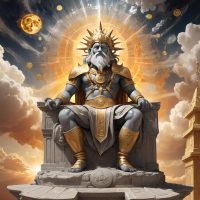Numi-Torum : The Supreme God
Listen
At a glance
| Description | |
|---|---|
| Origin | Mansi Mythology |
| Classification | Gods |
| Family Members | Postajankt-iki (Son), Kaltes-Ekwa (Wife), Hotel-Ekva, Etposzojka, Naj-Ekva, Kuly-Otir (Siblings) |
| Region | Russia |
| Associated With | Sky, Supreme Powers |
Numi-Torum
Introduction
Numi-Torum, also known as Num-Torum or Numi-Torem, is the supreme deity in the mythology of the Mansi people, an indigenous Finno-Ugric group inhabiting western Siberia. Revered as the ruler of the Upper World, he embodies divine justice, creation, and cosmic balance. As the head of the Ob-Ugric pantheon, which includes both the Mansi and the Khanty, Numi-Torum governs the forces of nature and the moral order of the universe. His influence shapes Mansi cosmology, where existence is divided into three realms — the Upper World (his domain), the Middle World (Earth), and the Lower World ruled by his adversary, Kul’-Otter. Deeply rooted in shamanic traditions, Numi-Torum symbolizes the harmony between the divine, the natural, and the human worlds, reflecting the Mansi people’s spiritual connection with their environment.
Physical Traits
Depictions of Numi-Torum are more symbolic than physical, emphasizing his transcendence and authority rather than human likeness. He is often imagined as an ancient, wise being holding a golden staff, radiating light and justice. His residence lies beyond mortal reach in the highest of the seven iron skies — each guarded by spirits loyal to him. His celestial palace is described as being built from gold and silver, glittering with eternal light. These descriptions convey not only his immense power but also his detachment from the human world. Natural phenomena like sunlight, thunder, and the northern sky are seen as reflections of his divine presence, reinforcing his association with weather, fate, and heavenly order.
Family
Numi-Torum’s family forms a vital part of the Mansi mythological structure. His most prominent son, Mir-Susne-Hum (also known as Mir-Susne-Khum or the “World Surveyor Man”), serves as the intermediary between gods and humans. Mir-Susne-Hum rides across the skies to maintain balance and deliver his father’s messages, embodying the principles of light, wisdom, and heroism. Numi-Torum is also said to have six other sons and one daughter, each ruling over different aspects of existence. His wife, Kaltes-Ekwa, the lunar goddess, oversees childbirth and destiny, connecting the divine with mortal life. His brothers, including Kuly-Otir (lord of the Underworld), Etposzojka (the Moon), and Naj-Ekva (Fire), represent the elemental forces that shape the Mansi cosmos. Through these relationships, Numi-Torum’s family symbolizes the interwoven balance of creation, death, and rebirth that defines Mansi spiritual philosophy.
Other names
Across the Mansi and Khanty traditions, Numi-Torum is known by various names that emphasize his celestial sovereignty and divine role. “Numi” or “Num” translates to “sky” or “heaven,” while “Torum” means “god” or “spirit,” making his name literally “Sky God.” Variants such as Num-Torum, Numi-Torem, and Torum-oika all reflect regional linguistic differences, yet they all denote his supreme position. He is sometimes referred to as “Torum-Ati,” meaning “Father Torum,” highlighting his paternal and protective aspects. Epithets like “Radiant,” “Luminous,” and “White as Gold” describe his purity and the divine light associated with him. These linguistic and poetic variations demonstrate how deeply Numi-Torum’s presence is embedded in the spiritual consciousness of the Ob-Ugrian peoples.
Powers and Abilities
As the supreme deity, Numi-Torum’s powers are all-encompassing, governing creation, fate, and cosmic order. The Mansi creation myth tells that he commanded a loon to dive into the primordial waters and bring up silt from the ocean floor. From this silt, the Earth was formed, establishing his role as the creator of the physical world. His dominion extends to the weather, the celestial bodies, and the moral laws that guide both gods and humans. Though omnipotent, Numi-Torum rarely intervenes directly in human affairs, maintaining his sanctity by operating through lesser deities or natural intermediaries. Shamans, during sacred rituals, attempt to reach his realm through spiritual journeys, but only the most powerful can enter his divine presence. It is said that Numi-Torum also determines the fates of mortals, sending messages about life and death through spirits and his divine children. His control over elements like thunder and wind further illustrates his role as a celestial governor who maintains equilibrium across the universe.
Modern Day Influence
The legacy of Numi-Torum continues to resonate among the Mansi and Khanty people, even as their traditional way of life adapts to modern realities. In contemporary Mansi culture, Numi-Torum remains a symbol of balance between humanity and nature — an enduring reminder of the sacred connection to the environment. Although Christianization and modernization have altered indigenous beliefs, the essence of Numi-Torum’s mythology persists in folklore, rituals, and oral storytelling traditions. Seasonal festivals and bear ceremonies, once held in his honor, have evolved into cultural heritage events that celebrate Mansi identity. In academic and artistic circles, Numi-Torum’s story has attracted growing attention. Ethnographers and mythologists, such as Dr. Marina Perevalova and Dr. Kisser, have documented his myths, exploring their links to ecological balance and ancient Finno-Ugric cosmology.
Modern literature and visual arts inspired by Siberian indigenous myths often portray Numi-Torum as a timeless guardian of the skies — a deity who watches over the world with wisdom and restraint. His archetype as the “Sky Father” parallels similar figures in other mythologies, from Odin to Zeus, underscoring a universal human tendency to associate the heavens with divine authority and protection. Among younger generations of Mansi, his image is being rediscovered through cultural revival movements that emphasize respect for ancestral traditions and spiritual ecology. These efforts frame Numi-Torum not merely as a mythic relic but as a living symbol of harmony and resilience, connecting ancient belief systems with contemporary environmental and ethical consciousness.
In recent years, local festivals, museums, and educational programs in the Khanty-Mansi Autonomous Okrug have reintroduced the mythology of Numi-Torum as part of regional identity-building. His name often appears in literature, songs, and community projects dedicated to preserving the language and spirituality of the Mansi people. Beyond folklore, his story has become a cultural metaphor — representing the balance between human progress and ecological preservation.
In essence, Numi-Torum stands not just as the creator of the world but as an eternal reminder of humanity’s place within it. His mythology teaches that existence thrives only when harmony prevails among the heavens, earth, and underworld. Through his enduring influence, the Mansi worldview continues to inspire respect for nature’s cycles, reverence for the unseen, and awareness of the divine order that governs all life. Even today, the name Numi-Torum — the radiant Sky God — echoes across Siberia as a testament to the enduring power of myth to shape identity, spirituality, and cultural continuity.
Related Images
Source
Folklore Earth. (n.d.). Mansi Mythology. https://www.folklore.earth/culture/mansi/
Perevalova, N., & Kisser, A. (Eds.). (2009). The Mansi. Spiritual Culture (Mythologies, Traditional Beliefs, Holidays and Rituals). Arctic Research Center, Museum of Anthropology and Ethnography, Russian Academy of Sciences. https://www.atlaskmns.ru/page/en/people_mansi_spirit.html
Wikipedia. (2023). Num-Torum. https://en.wikipedia.org/wiki/Num-Torum
Glavatskaya, E. (2024). Siberian Khanty Religious Traditions in the Everchanging World. George Fox University. https://digitalcommons.georgefox.edu/cgi/viewcontent.cgi?article=2586&context=ree
Goldberg, B. (2021). Fate and God in Mansi myths. Telos.lv. https://telos.lv/wp-content/uploads/2021/03/Goldberg-Telos-Mansi.pdf
Hoppál, M., & Pentikäinen, J. (1989). Uralic Mythology and Folklore. Finnish Literature Society.
Fedorova, E. (2000). The Ob-Ugrian Pantheon and Cultural Continuity. Sibirica, 4(1), 69-89.
Diószegi, V. (1968). Shamanism in Siberia. Akadémiai Kiadó.
Frequently Asked Questions
What is lorem Ipsum?
I am text block. Click edit button to change this text. Lorem ipsum dolor sit amet, consectetur adipiscing elit. Ut elit tellus, luctus nec ullamcorper mattis, pulvinar dapibus leo.
What is lorem Ipsum?
I am text block. Click edit button to change this text. Lorem ipsum dolor sit amet, consectetur adipiscing elit. Ut elit tellus, luctus nec ullamcorper mattis, pulvinar dapibus leo.
What is lorem Ipsum?
I am text block. Click edit button to change this text. Lorem ipsum dolor sit amet, consectetur adipiscing elit. Ut elit tellus, luctus nec ullamcorper mattis, pulvinar dapibus leo.
What is lorem Ipsum?
I am text block. Click edit button to change this text. Lorem ipsum dolor sit amet, consectetur adipiscing elit. Ut elit tellus, luctus nec ullamcorper mattis, pulvinar dapibus leo.
What is lorem Ipsum?
I am text block. Click edit button to change this text. Lorem ipsum dolor sit amet, consectetur adipiscing elit. Ut elit tellus, luctus nec ullamcorper mattis, pulvinar dapibus leo.





